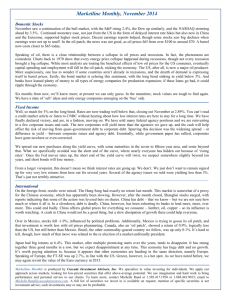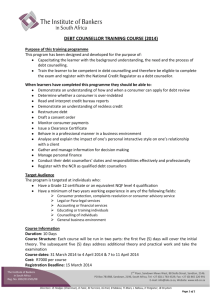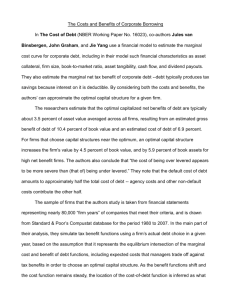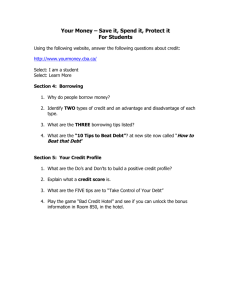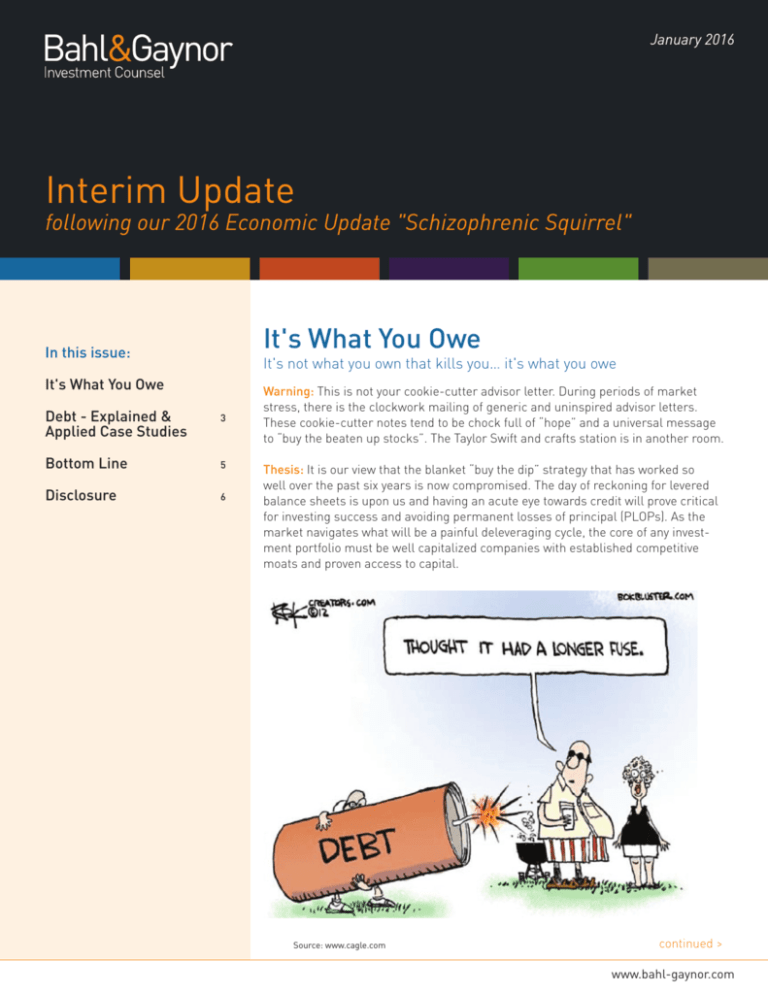
January 2016
Interim Update
following our 2016 Economic Update "Schizophrenic Squirrel"
It's What You Owe
In this issue:
It's not what you own that kills you… it's what you owe
It's What You Owe
Debt - Explained &
Applied Case Studies
3
Bottom Line
5
Disclosure
6
Warning: This is not your cookie-cutter advisor letter. During periods of market
stress, there is the clockwork mailing of generic and uninspired advisor letters.
These cookie-cutter notes tend to be chock full of “hope” and a universal message
to “buy the beaten up stocks”. The Taylor Swift and crafts station is in another room.
Thesis: It is our view that the blanket “buy the dip” strategy that has worked so
well over the past six years is now compromised. The day of reckoning for levered
balance sheets is upon us and having an acute eye towards credit will prove critical
for investing success and avoiding permanent losses of principal (PLOPs). As the
market navigates what will be a painful deleveraging cycle, the core of any investment portfolio must be well capitalized companies with established competitive
moats and proven access to capital.
Source: www.cagle.com
continued >
www.bahl-gaynor.com
It's What You Owe Continued
Over the past two decades, we’ve experienced firsthand
a few significant booms and busts within the credit
markets. During each boom, it felt as if the trend had
real permanence and extrapolations were sent to epic
proportions. And, the violent unwind of each of those
booms was stronger and longer than anyone had
thought. Glory. Greed. Fear.
Stearns, Lehman Brothers and the financial industry as
we once knew it in tatters. Only now, eight years later,
does the banking system appear to fully have its legs
underneath it.
Moving forward to today, the investment buzzword of the
2010s has been the “efficient frontier”. In its simplest
format, the thesis is that a portfolio is constructed with
seemingly less correlated assets to produce a maximum
return relative to the portfolio’s projected volatility.
For example, the LBO boom in 2006/2007 spawned
financiers to model buyouts north of $100bn. Home
Depot(!) was one of many rumored targets at the peak
of the frenzy. The LBO boom and credit market fears
spawned a derivative market whose trading would
dwarf that of the underlying securities. Structured
credit became mainstream and capital swarmed to
these newly created “AAA securities.”
The concept of “efficient frontier” has percolated into the
executive suite as CEO’s have been searching for the most
efficient capital structure. Aided not so subtly by activists,
the answer has universally been “more leverage” with a focused sweet spot on BBB/BB. Historically, there has been
a clear correlation between well-capitalized companies
outperforming their weaker counterparts during periods
of rising corporate leverage. However, that relationship has
not held since 2011 as the market has rewarded higher
leverage (indicated in the exhibit below). As a result of the
positive feedback loop, debt on corporate balance sheets is
now at levels not seen since the financial crisis.
In hindsight, the mega-LBO cycle busted spectacularly
and the derivatives associated created their own massive
unintended negative consequences. However, at the
time, fears of an over-extended M&A and credit market
were chalked up as “this time it was different”. Famous
last words. The violent unwind of this strategy left Bear
Historically low rates encouraged firms to lever without penalty (as of December 10, 2015)
Gap to be filled,
Huge disconnect
versus the credit
market!!!!
Source: Goldman Sachs Global Investment Research, 2015.
continued >
1
www.bahl-gaynor.com
It's What You Owe Continued
High-yield market growth
2000
1814
1800
1666
Market size ($bn)
1600
1562
1429
1289
1229
1400
1111
1200
1000
870
754
800
565
600
400
902 892
942 946 962 944
522
549
448
207 244 215 201 200
295
234 270
349
0
1988
1989
1990
1991
1992
1993
1994
1995
1996
1997
1998
1999
2000
2001
2002
2003
2004
2005
2006
2007
2008
2009
2010
2011
2012
2013
2014
YTD
200
Source: J.P. Morgan.
Chasing positive and “less correlated” returns, the
growing high yield investor base was more than willing
to accommodate the debt required for these newly “optimized” capital structures (without covenants, no less!).
Since 2008, the high yield market has expanded from
$944bn to $1.8trn, representing a near 100% increase.
It is our view that the problems we are witnessing with
deep cyclical and commodity-related firms are not simply
a matter of a flawed business model, but more of a flawed
capital structure thesis. It’s not the assets that these
firms own that is causing widespread losses; it’s the
debt they owe which is suffocating their firms.
The positive feedback loop was furious. Nearly every
purchase of high yield since 2008 has been a good one
with six consecutive years of positive returns until cracks
emerged in 2H15. Performance chasing and a historically strong credit cycle caused a rush of money into the
oxymoronic “high quality junk bond” strategies.
Similar to how the M&A had its violent unintended
negative consequences, the “efficient capital structure
thesis” is currently in the process of unwinding. Prior
capital provided to many firms is likely permanently
impaired. Further access to capital will prove to be
prohibitively expensive for current equity holders. A
blanket “buy the dip” mentality for the beaten-up names
will potentially compound losses. Without taking capital
structure into full consideration within an investment
thesis will prove to be a perilous exercise. To reiterate,
the game-plan has changed.
The majority of the new money can be classified as
“tourists” aka renters, not owners. As a class, these
tourists are unfamiliar with the risks and illiquidity and
only familiar with a recent history of strong returns.
Similar to the cracks that emerged in late 2007 in the
mortgage market, cracks emerged over the past six
months in levered credit. Faced with the prospect of deep
and sustaining outflows, we’ve heard numerous times
how the high yield capital markets have “evolved” and
are better equipped to withstand financial shocks. In
summary, we’ve again been told “this time it’s different.”
At Bahl & Gaynor, we are taking an extremely proactive
approach as we discussed a few weeks ago in our 2016
Outlook, “Schizophrenic Squirrel”. We continue to aggressively emphasize the view of moving further up-in-quality
via owning well-capitalized companies with established
moats and proven access to capital.
continued >
2
www.bahl-gaynor.com
Debt – Explained & Applied Case Studies
In its most basic form, debt is consumption pulled forward. So long as assets are rising in value and
the world is viewed through an Excel spreadsheet, the most efficient capital structure is one that is
more levered. However, when economic cycles are experienced, there are periods where asset prices
go down… swiftly and significantly.
Debt has to be repaid. Whether the debt is paid down
perfectly coincided with the optimal capital structure
thesis. However, there are real cracks in that thesis. For
example, many mining companies are still investment
grade. Freeport-McMoran (FCX), a highly levered mining
firm, has seen the market value of its debt drop nearly
60% as the price of copper has been decimated (chart
below). Despite this, FCX still remains Baa3/BBB- at
Moody’s and S&P, respectively. History rhymes again
with the rating agencies?!?!
or rolled over, levered corporations are in constant need
of hospitable capital markets. In times of financial stress,
only the least levered and least risky business models
have ready access to capital. Financial conditions currently
are materially worse than any other period since the
Financial Crisis. Not only are financial conditions in stress,
they have been steadily trending higher since June of
2014. Said differently, the trend is not your friend if you
are captive to the capital markets.
For companies in distress, the debt is now the equity. Considering FCX, with its debt in the mid-40s and a 17% yield,
the market is demanding equity-like return for owning
the debt. Therefore, FCX’s roughly $4.5bn equity market
value is an option on survival and copper prices, effectively
a warrant. Owning these “warrant-like” securities is only
for the bold and those able to withstand material volatility.
There are old pilots and bold pilots, but no old, bold pilots.
Exhibit: Financial Conditions Are Tighter Than At Any Time
Since the Financial Crisis
FCX is just one example. Despite being “investment
grade,” the company currently has zero access to the
traditional capital markets. Using credit ratings alone
and not respecting access to capital is a recipe for critical
errors and permanent losses.
Exhibit: Freeport-McMoran 2024 Debt: $44, 17%,
But Still Investment Grade!?!?!?
Source: Goldman Sachs Global Investment Research
Credit Ratings do not define High Yield;
a “High Yield” defines High Yield.
With the boom in high yield, so followed has been the
boom in BB-rated debt strategies. These Core+ portfolios
have been popular considering the historically low default
rate on debt with that rating relative to the yield received.
It’s no coincidence that the popularity of these strategies
Source: Bloomberg
continued >
3
www.bahl-gaynor.com
Debt Continued
Debt Is a Competitive Handcuff.
as investors have worried about Sprint’s viability with its
hemorrhaging cash flow. These worries have become
a self-fulfilling prophesy as the financing spread has
exploded to nearly 20%!
Let us consider the competitive landscape in the telecommunications market. There are four major carriers:
Verizon, AT&T, T-Mobile and Sprint. As the quality of
the network has improved, wireless service has become
increasingly viewed as a commodity. By definition, a
commodity has near-zero pricing power. So, for most
customers, the choice between the four carriers simply
comes down to price.
At a 15-20% financing cost differential, Sprint faces
the following options:
1. Charge more for it services.
2. Redirect capital from network improvement
to debt pay-down.
3. Cease to exist as a stand-alone entity.
With a very capital-intensive business, all four firms
relied heavily on the debt capital markets to finance their
networks. On a relative basis, Verizon and AT&T have
materially more conservative capital structures versus
Sprint. Over the most recent investment cycle, the higher
financing cost was not an issue as the cost of Sprint’s debt
versus the leading carriers was only 3% higher. However,
that difference has exploded over the past four months
Given that we have a commodity-like business, Sprint
cannot charge more. Moreover, “kicking the can” on
capital expenditures will guarantee an inferior product
and accelerate subscriber losses. In effect, the debt
market is holding Sprint hostage. “Hostage” is not a
term one wants associated with his or her holdings.
Exhibit: Sprint Held Hostage By Capital Markets
Source: Bloomberg
The Bottom Line
While history does not repeat, it certainly rhymes. This time it is not different. Corporations that have depended on the
depth of the capital markets for their expansion are firmly in the crosshairs. As opposed to the past six years, a “V-shaped”
recovery in credit spreads is not coming. Similar to the unwind of prior credit booms, this deleveraging cycle will be longer
and deeper than market expectations. With a contracting credit market, further access to capital will be at progressively
more punitive terms.
In conclusion, Bahl & Gaynor views that any investment thesis will require strong backbone of credit analysis and view on
capital market access. Therefore, the core of any investment portfolio must be well capitalized companies with established
competitive moats and proven access to capital.
continued >
4
www.bahl-gaynor.com
Thanks
Your continued support and interest is much appreciated.
Everyone at Bahl & Gaynor would like to thank you for the opportunity to serve your investment
needs. Please feel free to contact any member of the Institutional Client Service Team through
the information provided below if you have questions.
Sincerely,
Important Disclosures
Legal Stuff
This material is distributed by Bahl & Gaynor, Inc., and is for information purposes only. Bahl & Gaynor, Inc., does not represent that
the information is accurate or complete and it should not be relied on as such. It is provided with the understanding that no fiduciary
relationship exists because of this report. Bahl & Gaynor, Inc. assumes no liability for the interpretation or use of this report. Investment
conclusions and strategies suggested in this report may not be suitable for all investors and consultation with a qualified investment
advisor is recommended prior to executing any investment strategy. No part of this document may be reproduced in any manner without
the written permission of Bahl & Gaynor, Inc. Copyright Bahl & Gaynor, Inc., 2016. All rights reserved.
5
www.bahl-gaynor.com




